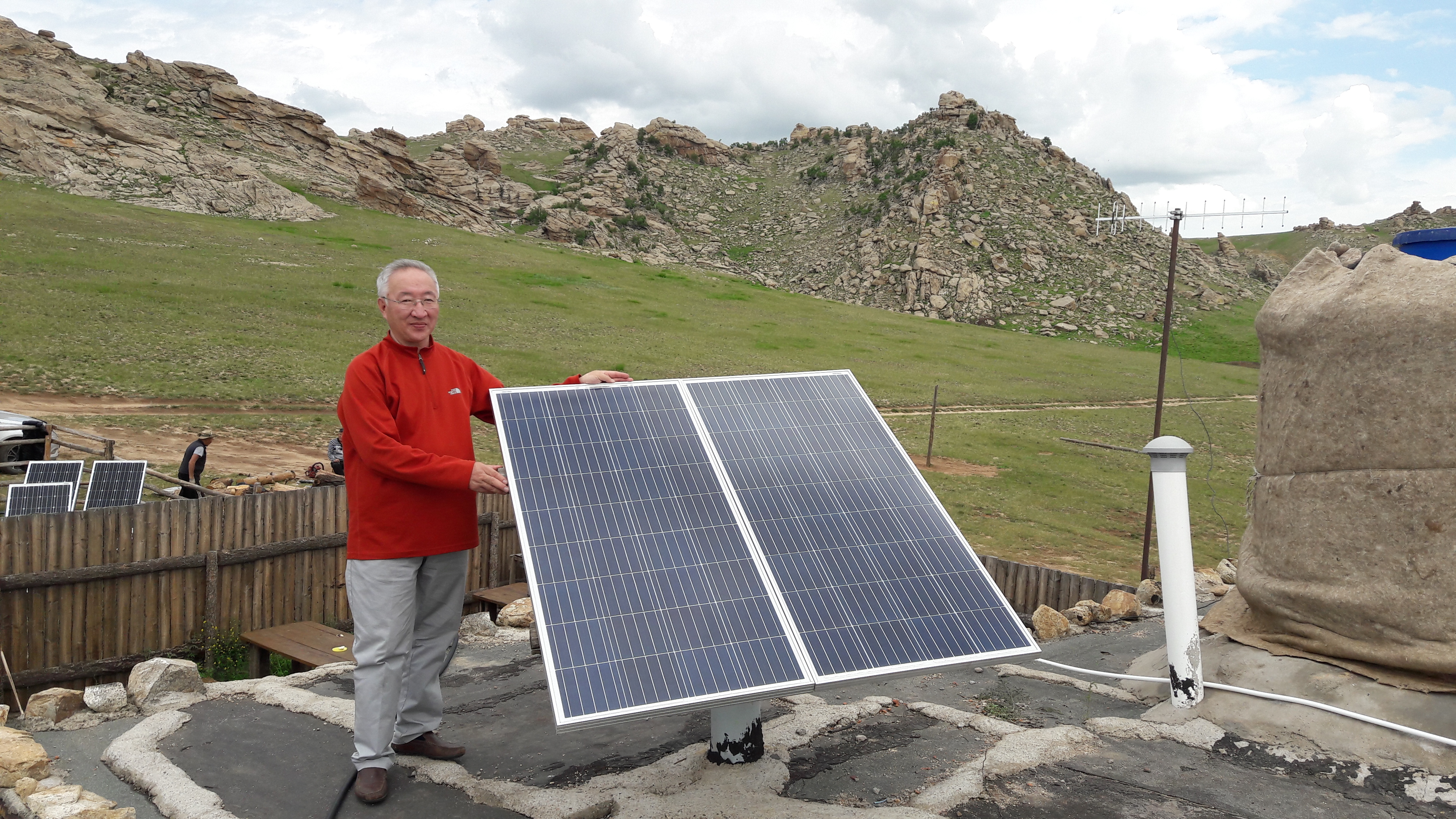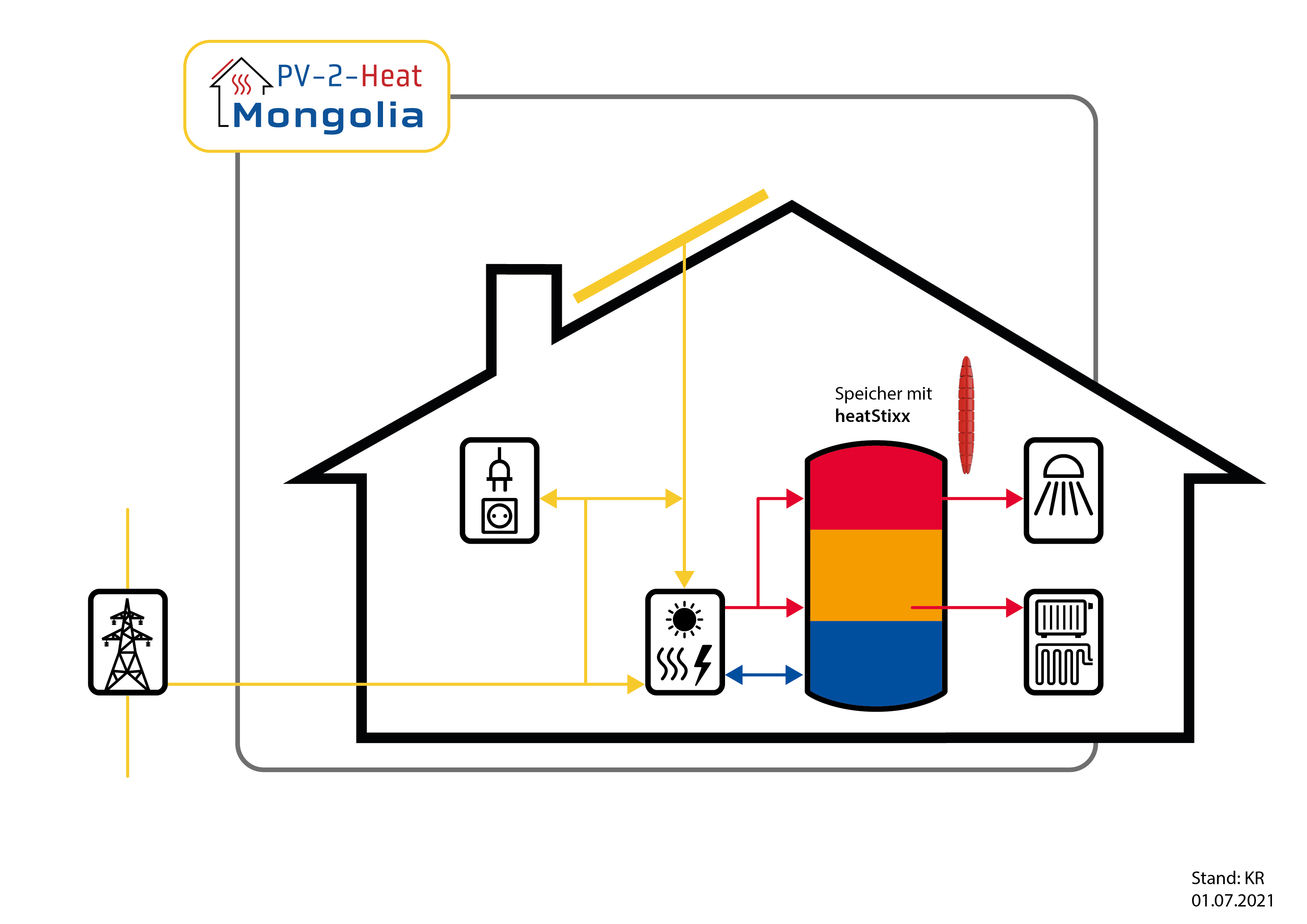

Affordable and clean energy
Good health and well-being
Sustainable cities and communities
Climate action
Partnerships for the goals
Coordinator: ESDA Technologie GmbH
Contact person: Sven Jona
Address: Bahnhofstraße 31,07607 Eisenberg/Thüringen
Phone: +49 (0) 36691 53118
Email: sven.jona(at)axiotherm.de
Project partners in Germany
- Klaus Rauch consulting engineer
- WestfalenWIND Planungs GmbH & Co. KG
- Universität Paderborn - Kompetenzzentrum für nachhaltige Energietechnik (KET)
Project partners in Mongolia
- Solar Energy Consulting LLC
- RTT LLC
- National University of Mongolia (NUM)
- Mongolische Akademie der Wissenschaften (MAS)
PV-2-Heat to Mongolia
Ulaanbaatar, the capital of Mongolia, is the world’s coldest capital city. During its seven long months of winter, temperatures of minus 30 °C are normal, meaning residential buildings have to be heated permanently. Old coal-fired power plants from the 1960s without flue gas filters combined with traditional heating methods using coal, wood and waste products of all kinds have led to extreme air pollution. A huge dome of smog has become part of everyday life and causes nearly 4,000 deaths every year, according to the World Health Organization. Within the research project, an international consortium is developing clean, safe and affordable heating solutions for residential buildings and quarters in Mongolia.
Objectives
The PV-2-Heat to Mongolia project aims to support Mongolia in reducing the extreme air pollution caused by traditional heating methods with coal, wood and waste in the capital Ulaanbaatar by using renewable energies. To this end, PV-to-heat systems, which convert energy generated by photovoltaics (PV) into heat, will be adapted to the harsh climatic conditions in Mongolia and integrated into the Ulaanbaatar power grid before being tested as pilot plants in various environments. However, for this environmentally friendly technology to be successful, the government needs to create incentives to use it. Therefore, the project will also enable the Mongolian government to up-scale PV-to-heat technology and thus provide the population with a sustainable supply of renewable electricity and CO2-free heat.

Development and innovation
To date, no PV-to-heat systems have been able to work reliably under the extreme conditions of the Mongolian winter with its temperatures of up to -40 °C and generate sufficient heating power, something that is now possible thanks to innovative, PCM-based latent heat storage elements. In addition, existing systems are that complex from a technical perspective that they have not been able to gain currency in Mongolia due to the high costs of their electronic components. Furthermore, there is no guarantee that the systems can be operated safely in the long term, as there is a lack in qualified personnel for maintenance work.
The project is divided into two parallel paths: with regard to the generation of electricity, the project team aims to integrate PV systems including control and feedback control technology into Ulaanbaatar's existing electricity grid and, finally, prepare for subsequent up-scaling. With regard to the heat supply, the team will assess the conditions in which the PV-to-heat systems will be operated in the building stock in Ulaanbaatar, taking the extreme climatic conditions in Mongolia into account. Based on this assessment, the team will then develop the system components and design system integration methods for various buildings and applications. Once the PV-to-heat systems have been adapted to Mongolian conditions, the team will test pilot installations in 10 residential and 5 public buildings such as schools and business locations, all of which have different structures.

The consortium and distribution of tasks
The PV-2-Heat to Mongolia project will transfer innovative, ecologically sustainable power-to-heat technology to Mongolia with the aim of reducing extreme air pollution in the capital Ulaanbaatar – always providing it is up-scaled by the Mongolian government. The project team will use a range of test environments to familiarize different user groups – e.g. private households, trade and industry, government institutions – with the new technology, so that they can act as multipliers. Finally, the German-Mongolian cooperation aims to promote technical and economic cooperation beyond the scope of the project; the German companies involved are also planning long-term activities in Mongolia.
Companies ESDA Technologie and Klaus Rauch consulting engineer are responsible for adapting the PV-to-heat systems to the requirements of Mongolian winters, while WestfalenWIND covers the generation and commercialization of renewable energies within the project. The Centre for Sustainable Energy Technology (KET) at Paderborn University provides scientific support; as a well-connected coordinator, Prof. Enebish Namjil acts as the link between local scientific and entrepreneurial partners in Mongolia. Members of the National University of Mongolia and the Mongolian Academy of Sciences will provide scientific support during the set-up and testing of the PV-to-heat systems.
CLIENT II project PV-2-Heat featured in FONA newsletter

CLIENT II at climate conference in Dubai

